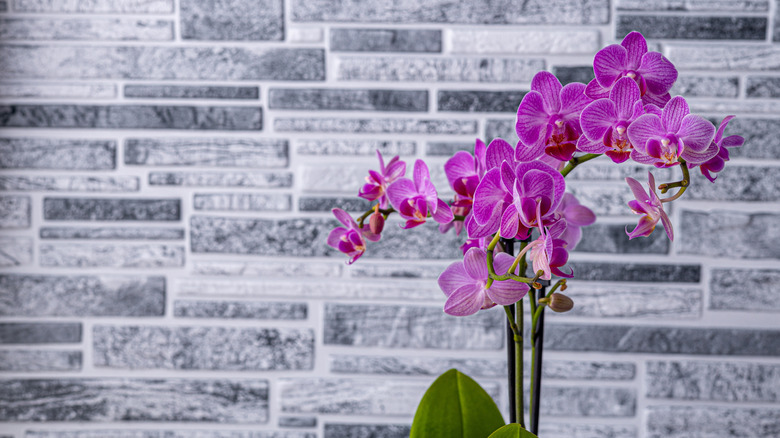Speed Up Your Orchid's Growth With One Easy Trick
There are over 28,000 species of orchids that grow all across the globe, making the Orchidaceae family one of the largest groups of flowers in the natural world. Given that many orchids are epiphytes, growing as outcroppings of other plants or rocks using aerial roots rather than being planted firmly in the dirt, multiple varieties of orchids are also perfect indoor houseplants. Whether you're growing a moth orchid (genus Phalaenopsis), a cane orchid (genus Dendrobium), or a corsage orchid (genus Cattleya), you'll find a lot of commonalities — including the fact that your bathroom might be the perfect room to grow some of these tropical flowers. One tip you can apply to orchids writ large is taking to their stems with a pair of tweezers to help encourage the growth of branching stems.
This tip, as shared by Mama Judy of @JudyBaoGarden on TikTok, is easy to try regardless of your current level of gardening expertise. Once your orchids are planted and you begin to see their stems branching out, you should find jointed segments where new buds appear to be growing. Look for segments where these budded outcroppings are wrapped in a thin membrane at the joint; this membrane is what you should aim to peel with your tweezers, carefully pulling it off around the width of the stem. Once that membrane is removed, your budding orchid nodes will be unrestrained and able to grow faster, giving you more potential flowers once these perennials are in season to bloom.
How to set up your budding orchids for success
Before getting to the stage where you can peel the restraints away from stemming nodes, you'll want to give your orchids the best chance for success. Orchids are often considered difficult to grow, but general consensus is that this conception stems from the wide variety of growing conditions inherent to each kind of orchid. For example, take moth orchids (also called moon orchids) — a genus which is considered the right type of orchid for beginners to grow. If you want to set up Phalaenopsis for success in your home, these plants thrive in light conditions which range from deep shade to dappled sunlight, and they prefer a more acidic soil. Moon orchids tend to grow best in USDA hardiness zones 10 and 11, which gives them the best chance in regions of Southern California and Florida, as well as islands off the mainland, including Hawai'i and Puerto Rico.
Of course, growing your orchids indoors means you can recreate those environmental conditions, especially in rooms with a humid ambiance like your bathroom. Phalaenopsis prefer a moist growing medium, one that's well-drained with a lot of aeration to mimic epiphyte conditions. For example, consider growing these orchids with sphagnum moss or using the bark of a fir tree, and you can directly mist the roots if they are exposed. These tips apply to just one genus, so do some research if you'd prefer to grow a variety like dancing lady orchids (genus Oncidium) or need specific advice on how to successfully care for indoor orchids. Regardless of what you grow, freeing those budding nodes is a great trick to foster as many blooms as possible.
